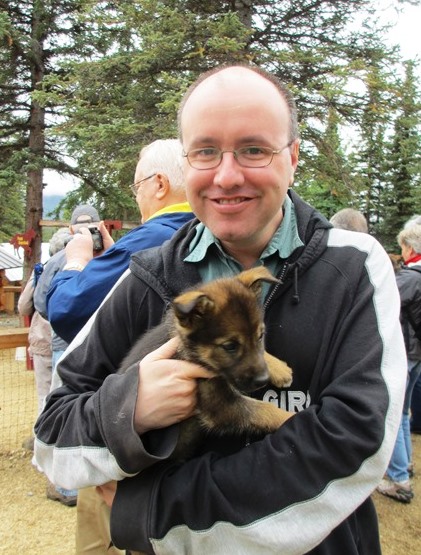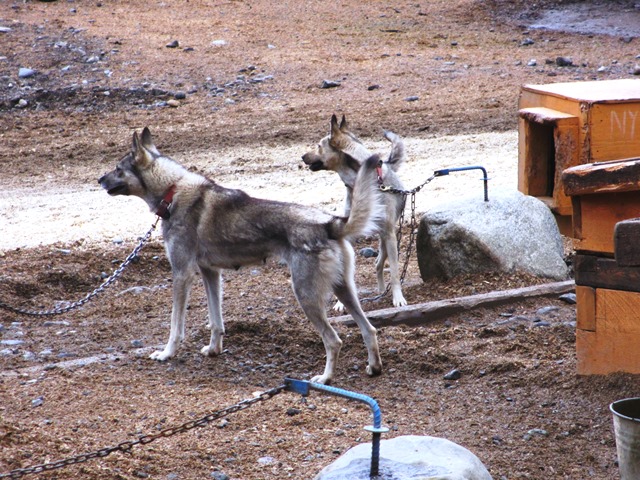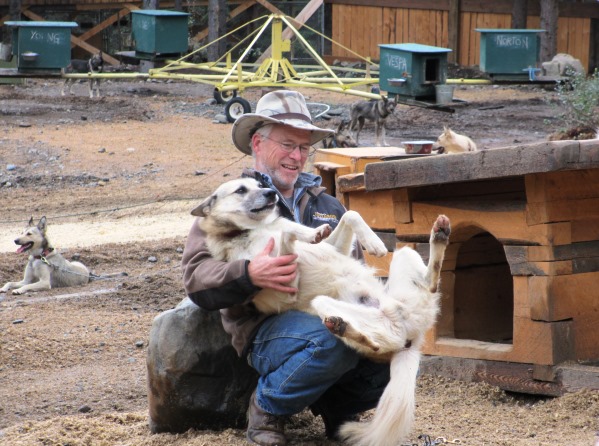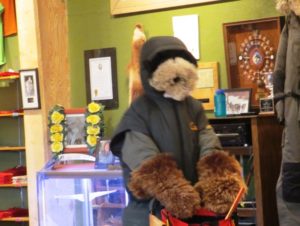One of the most popular activities in Denali National Park is a visit to Husky Homestead, the kennel and headquarters of Jeff King, a 4-year Iditarod champion recognized as the “Winningest Musher in the World”. The Iditarod is an annual sled dog race that takes place in early March. Over the course of 9 to 15 days (or longer) mushers travel from Anchorage to Nome, Alaska with a team of 16 dogs. On even-numbered years (such as 2014) the race follows a northern route, which amounts to 1,112 miles in total.
The 2-1/2 hour Husky Homestead Tour departs 3 times daily during the summer months, picking up at Denali area hotels between mile 229 and 239 of the Parks Highway. After a short transfer, you are met at the Husky Homestead grounds by kennel staff bearing gifts of yelping, squirming puppies. You are welcome to take your own photos and videos of the puppies. Or you may also pose for a staff photographer to take your photo, with the option to purchase later (no commitment necessary).
You have 10 minutes with the puppies before being ushered into an outdoor area with bleachers for the next part of the presentation. Jackets and blankets are provided to any guests who may need them. Kennel staff members explain that your time with the puppies is actually very helpful in socializing them toward any future contact with humans. For any puppies selected for mushing, it’s imperative that they can interact with any human from any walk of life. Every person has a different smell, age and mannerism. Successful mushing dogs will be able to interact with anyone they may encounter.
Next you are given an overview of the training regimen the puppies go through and how they are selected to go further in the world of competitive mushing. Not all dogs are suited for Iditarod competition. Some may excel in other types of racing and could be sold to other breeders. Other dogs may, for a number of reasons, be more suited to be a family pet. Part of responsible breeding and racing is finding a good home for each dog, one where they will be loved and appreciated.
Husky Homestead Tours utilizes Alaskan huskies for breeding and racing, the most common breed for Iditarod racing. The first surprise to many visitors is that the dogs are not the pure-bred, fluffy, attractive breeds so often portrayed in the media – breeds like the Siberian Husky, Samoyed or Alaskan Malamute. Alaskan huskies are in fact mongrels, bred specifically for sled dog performance attributes.
Alaskan Husky lineage could consist of any of the following breeds: Siberian Husky, Alaskan Malamute, Pointer, Saluki, Greyhound and even part wolf, although wolf lineage is not encouraged since that often makes them more difficult to control. The dogs, in other words, all look completely different from each other and they are not necessarily attractive. These dogs were bred for toughness and endurance, not to win dog shows.
You learn much more at this time of the presentation, and it’s a lot to try to absorb. During the off season the dogs’ diet consists of 1,500 calories a day. During the winter months the daily allowance jumps up to 4,000 calories a day. You also learn about how the dogs’ unique fur helps protect them against the elements. You learn about how the dogs are named, a process that is necessarily complicated due to the number of dogs involved. For example, one dog is named “Kroner” after the Norwegian currency. Kroner is part of the “International Currency” litter.
Jeff King selects from among the dogs to do a short practice run, having them haul him around the property on an ATV. The dogs howl and beg to be picked for the short run, removing any doubt that these dogs love what they do. On this day, Jeff continued his talk while cradling one of the dogs in his lap like a baby and rubbing its tummy. It’s clear that the dogs are not just a career choice for him, but rather he loves each and every one of them as a member of his extended family. We then get a demonstration of one of the dogs training by running round and round in an oversized exercise wheel.
The presentation then moves into a large adjacent building for the remainder of the tour. Within the building, you find a bench seat on a set of bleachers. Jeff then continues his talk, this time getting much more into the nuts and bolts of competitive dog mushing. Jeff King’s talk is highly scripted, and he has it down pat. First, Jeff gives information about his background, including how he got involved with dogs and what made him move to Alaska. The rest of his talk revolves mostly around his racing experiences, training regimen and care for the dogs. A main takeaway point is that the dogs are the athletes and that his role is that of a caregiver there to make sure the dogs’ physical and emotional needs are met.
If you have seen the excellent Husky Homestead Tours promotional video on Vimeo, then parts of this presentation will seem familiar. If you haven’t seen the video yet, please take a couple minutes to watch the video below. You won’t be disappointed.
Husky Homestead: A Denali Destination… Where Dogs are King! from Husky Homestead on Vimeo.
Dog mushing is mentally challenging for the mushers, like a game of chess, but it is not especially physically demanding. There are no distinctions in the Iditarod between men and women mushers, and there is no senior division. Col. Norman D. Vaughan completed 6 Iditarod races, the last in 1990 at the age of 84. Dog mushing is truly a sport that anyone who is reasonably fit can participate in, provided they have the will and desire.
Jeff gets into some very specific information during his talk, some of which it can be difficult to fully process. I found it interesting to hear about the day-to-day gruel of what an Iditarod race is like. The dogs are actually very well protected by a strict set of rules in place. During the race, Jeff’s team runs for 6 hours on, then 6 hours off. During the 6 hours of “down-time”, while the dogs are resting, Jeff cooks food for himself and his team, massages the dogs and stretches their muscles, and inspects the dogs’ feet and cares for any injuries.
When all is said and done, Jeff himself will typically only sleep for 2 of the 6 hours, meaning 4 hours of sleep every 24 hours, if he’s lucky. When he does sleep, it’s outside in the frigid cold, since it would take too much time to go indoors and remove all his clothing and then have to put it all on again. Jeff has a Homestead employee demonstrate the clothing that dog mushers use during a race. Suffice to say, the clothing that professional dog mushers is well beyond what you may find in a typical outdoors store.
Warmth and comfort are key in order to sustain the rigors of the Iditarod race, and tough guy posturing has no place in an event where it’s a struggle simply to finish. The Iditarod rewards those who come prepared, who take care of themselves and their dogs, and who take the extreme weather conditions very seriously. Mushers must be prepared to face whiteout conditions, sub-zero temperatures and gale-force winds which can cause a wind chill as low as -100° F (-73° C).
Jeff talks about what attributes he looks for in each of his dogs and how he selects them for positions on his team. One interesting tidbit is that he tends to use female dogs to race less frequently due to an incident some years ago when a female dog went into heat in the middle of a race. This understandably led to major problems for the team and he needed to send the dog home and continue without her. Due to the possibility of females going into heat, the females need to prove themselves to be even better than the males, but every year Jeff runs female dogs in his Iditarod team. After giving his talk, Jeff then answers questions from the audience, which can cover everything from how he cooks to how he relieves himself during a race.
Afterward, you have approximately 10 to 15 minutes to peruse the gift shop, where one of the most popular purchases is Jeff King’s dog mushing memoir, Cold Hands, Warm Heart: Alaskan Adventures of an Iditarod Champion. Other popular souvenirs include stuffed animals, postcards and calendars. Of, if you prefer, purchase the photograph of you holding a puppy from earlier in the tour. Make your purchase decisions quickly, though, as there’s only a limited amount of time to shop. Afterward, you are transferred back to your hotel, left with a life-long memory and at least a basic understanding of the sport of dog mushing.
After reading this far, you may be wondering how Jeff King’s team fared in the 2014 Iditarod. Jeff’s team had been at or near the front of the competition for much of the race, only to be side-lined by Mother Nature in the final 80 miles. His harrowing experience was covered by the Alaska Dispatch. In the article, you can read about how relentless coastal winds forced his team to stop and hunker down in the bitter cold. Realizing they could not wait out the storm without freezing, Jeff abandoned his team to walk three miles to the next checkpoint of Safety. Thankfully, he was picked up along the way and was then able to safely retrieve his animals.
For a complete list of Alaska-related content, please see the below:
- Arctic Circle Air Adventure with Northern Alaska Tour Co.
- Exploring Juneau, Alaska with Holland America Line
- Jeff King’s Husky Homestead in Denali
- Seattle cruises to Alaska | an introduction
- Visiting Mendenhall Glacier on layover at Juneau Airport
- Welcome to Denali, home of the $9 Subway footlong
- 2011 Seattle cruises to Alaska: Holland America Line
ErikTomrenWrites is a participant in the Amazon Services LLC Associates Program, an affiliate advertising program. Your purchases on Amazon.com via our links will help support ErikTomrenWrites – at no extra cost to you!







Pingback: Seattle sister cities – an overview - #ErikTomrenWrites